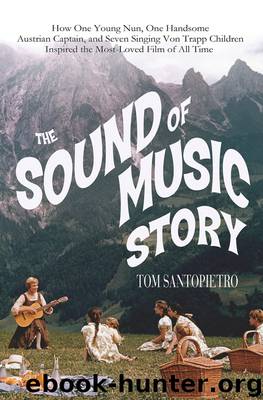The Sound of Music Story by Tom Santopietro

Author:Tom Santopietro
Language: eng
Format: epub
ISBN: 9781466870598
Publisher: St. Martin's Press
17.
PUBLICITY
Even before the two previews, Fox had decided to spend substantial sums on publicizing their family-friendly film, but after the sensational response at both screenings, the studio granted Kaplan and his team of publicists a very healthy advertising budget of $3,000,000. There was to be no question of a wide release. Instead, there would be a carefully calibrated slow roll out for the film: a small number of theaters—131 to be precise; reserved seats; and a limited number of shows each day. The Sound of Music would be positioned as a bona fide moviegoing event.
The strategy was set, but the advertising artwork remained unfinished. Where was the one piece of art that captured the film’s appeal at a glance? Version after version was drafted only to be summarily rejected. Nothing seemed to precisely capture the film’s high spirits and tale of redemptive family love. One after another, twelve versions were nixed until everyone agreed that the answer had finally been found: Julie Andrews—front and center cresting the top of a hill, smile in place, feet off the ground in happiness—guitar and carpetbag swinging freely in the foreground. Christopher Plummer—off to the side, stern, forceful, hands on hips, handsome. Seven grinning children in matching yellow outfits running up the hill behind Julie Andrews. Music, scenery, and smiles. Happily ever after. Or, as the tagline would have it: “The Happiest Sound in All the World.”
Sold.
Next. How to custom tailor the publicity for each of the film’s limited number of markets? Kaplan began working overtime, personalizing the publicity by crafting separate stories for each city where the film would be released. Basic strategy: let the word of mouth build so that people would actually travel some distance to see the film. Make The Sound of Music an event guaranteed to propel middle-American families out of the house.
The Sound of Music would not be shown in small theaters with screens positioned uncomfortably close to the projection booths. The 1920s movie palaces with outlandish yet secretly thrilling Moorish design may have all but vanished, but enough stand-alone single-screen theaters remained to comfortably house the widescreen release and make this moviegoing experience a throwback to the days of ushers in uniforms.
Kaplan wrote up the actual technical specifications of Todd-AO widescreen projection, even if few really understood the detailed jargon. Anything to make The Sound of Music seem unique. Todd-AO projection, which had been developed under the aegis of producer Mike Todd, in conjunction with the American Optical Company, utilized film stock 65 millimeters wide; the width of the projected image, not the depth of field, would prove the key, the end result being a movie projected in a 2:35:1 aspect ratio—an image over two times wider than high. Providing theaters with a simpler format than that of three-strip Cinerama, featuring a brighter and steadier image than that produced with CinemaScope, and with speakers placed behind the screen and throughout the theater, Todd-AO utilized six magnetic stereo tracks rather than the standard four. (With the six tracks
Download
This site does not store any files on its server. We only index and link to content provided by other sites. Please contact the content providers to delete copyright contents if any and email us, we'll remove relevant links or contents immediately.
| Coloring Books for Grown-Ups | Humor |
| Movies | Performing Arts |
| Pop Culture | Puzzles & Games |
| Radio | Sheet Music & Scores |
| Television | Trivia & Fun Facts |
The Kite Runner by Khaled Hosseini(5085)
Gerald's Game by Stephen King(4584)
Dialogue by Robert McKee(4323)
The Perils of Being Moderately Famous by Soha Ali Khan(4169)
The 101 Dalmatians by Dodie Smith(3454)
Story: Substance, Structure, Style and the Principles of Screenwriting by Robert McKee(3397)
The Pixar Touch by David A. Price(3366)
Confessions of a Video Vixen by Karrine Steffans(3246)
How Music Works by David Byrne(3187)
Fantastic Beasts: The Crimes of Grindelwald by J. K. Rowling(2995)
Harry Potter 4 - Harry Potter and The Goblet of Fire by J.K.Rowling(2990)
Slugfest by Reed Tucker(2942)
The Mental Game of Writing: How to Overcome Obstacles, Stay Creative and Productive, and Free Your Mind for Success by James Scott Bell(2845)
4 - Harry Potter and the Goblet of Fire by J.K. Rowling(2657)
Screenplay: The Foundations of Screenwriting by Syd Field(2576)
The Complete H. P. Lovecraft Reader by H.P. Lovecraft(2514)
Scandals of Classic Hollywood: Sex, Deviance, and Drama from the Golden Age of American Cinema by Anne Helen Petersen(2465)
Wildflower by Drew Barrymore(2445)
Robin by Dave Itzkoff(2386)
